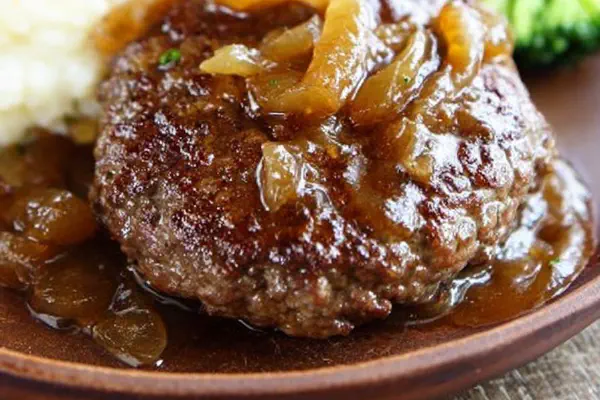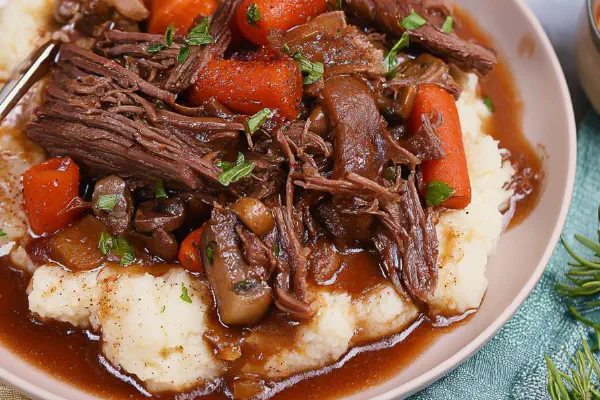Hearty Beef Tips Stew

By Emma
Certified Culinary Professional
Ingredients
- 2 ½ pounds beef stew meat cut into cubes
- 3 tablespoons olive oil divided
- 1 medium onion diced
- 2 ¼ cups beef broth
- 1 envelope onion soup mix
- 1 tablespoon tamari sauce substitution for Worcestershire
- ½ teaspoon salt adjust to preference
- ¼ teaspoon black pepper freshly ground
- 1 bay leaf
- 2 tablespoons cornstarch
- ¼ cup cold water
- 2 tablespoons fresh parsley chopped for garnish
About the ingredients
Method
- Heat 1 tablespoon olive oil in a sturdy 5-quart pot over medium-high. Add half beef cubes, spreading flat. No crowding. Sear until all sides deep brown, juices tighten, 6-8 minutes by smell and sizzle, not timer. Remove with slotted spoon, set aside bowl.
- Add 2nd tbsp olive oil, repeat with remaining beef, same method. Avoid steaming; brown ensures flavor and texture. Set meat aside with first batch.
- Lower heat to medium, pour in remaining olive oil. Toss in diced onions. Stir gently. Watch edges soften, translucence spreading. Smell anchors savory base. Around 3 minutes, onions tender but still firm, not caramelized.
- Return beef cubes to pot. Pour beef broth slowly, deglazing bottom bits—the browned stickies, gold flavor. Sprinkle onion soup mix evenly. Add tamari instead of Worcestershire for richer umami, less sharpness. Salt and pepper in now, toss bay leaf on top.
- Bring to low simmer, cover pot, reduce heat just enough so gentle bubble appears. Leave it undisturbed for 1 hour 30 minutes but check after an hour. Beef should start feeling tender to poking with fork; if tough, give 15 more minutes. Slow simmer crucial—hurts texture if too high or fast.
- Remove bay leaf before thickening. Mix cornstarch and cold water thoroughly in small bowl till smooth slurry free of lumps. Pour into beef stew while stirring steadily. The mix thickens quickly, around 2 minutes. Stop stirring when coating spoon nicely.
- Final step sprinkle chopped parsley. Gives fresh heat contrast and herbal brightness that cuts richness. Serve hot with rustic bread or buttered noodles.
- Watch for excess liquid before thickening; skim fat if too greasy to avoid a slick stew. If no broth, beef stock cubes diluted work fine.
- Alternative oils like avocado or grapeseed can replace olive oil for cleaner fat taste. Onion powder can substitute soup mix for simpler version but less complexity.
Cooking tips
Chef's notes
- 💡 Sear beef in two batches avoid steaming; crowding traps moisture steam leaves no crust. Listen for that sharp sizzle sound; should stop once meat releases easily from pot. Browning triggers flavor, texture; gray spots mean missed caramelization. Don’t rush turning pieces. Use medium-high heat, hot oil; olive oil best for flavor but swap avocado or grapeseed if you want cleaner fat or higher smoke point.
- 💡 Onions translucent is key not browned; softening releases savory aroma and base but caramelizing makes sweeter, changes profile. Stir gently edges soften first smell after 3 minutes tells timing. Lower heat after beef sear; high heat fries too hard. Adding tamari instead of Worcestershire cuts sharp bite, adds mild sweetness and umami depth. Adjust salt carefully; broth or cubes vary salt.
- 💡 Cornstarch slurry needs cold water mix fully lump free before pouring. Pour slowly into simmering stew stir steady or lumps form. Thickening happens fast 1-2 mins; stop stirring once sauce coats spoon or turns gluey. Too thick or thin? Adjust water or cornstarch ratio. Remove bay leaf before slurry to avoid bitterness — leaves harsh tone if left simmering past step.
- 💡 Slow simmer low heat method crucial. Tiny bubbles barely breaking surface. Stirring too much breaks beef fibers mushy, no good. Check tenderness after an hour by probing meat with fork; if tough extend 15 min more; overcooking turns mushy and loses texture. Watch steam and saucepan lid—keep moisture locked but don’t boil rapidly.
- 💡 Parsley fresh added last brightens rich fatty stew flavor. Avoid dried unless quantity reduced; dried stronger. Skim excess fat after simmer if greasy; layer forms on top when simmering long. Broth can be beef stock cubes dissolved in water if no liquid broth handy. Onion soup mix shortcut for herbal savory punch; replace with onion powder plus extra herbs but less complexity.
Common questions
Why sear beef in batches?
Avoids steaming which kills crust. Crowded pan traps water released from meat. No crust = bland. Better browning locks juices. More batches slower but worth it.
Can I use Worcestershire instead of tamari?
Yes but tamari sweeter, less sharp. Worcestershire adds tang, more punch. Tamari brings umami without bite. Either affects flavor balance differently depends on taste choice.
How to fix a stew too thin?
Use cornstarch slurry mix cold water smooth lumps. Add bit by bit while stirring until coating spoon. Let simmer couple mins. Repeat if needed. Avoid flour thickening unless roux done first.
How to store leftover stew?
Refrigerate in airtight container up to 3 days. Reheat gently to avoid toughening beef. Freeze for 2-3 months best in portion sizes. Thaw overnight fridge preferred. Stir before serving if separated.



